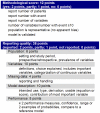Prediction of mortality in very premature infants: a systematic review of prediction models
- PMID: 21931598
- PMCID: PMC3169543
- DOI: 10.1371/journal.pone.0023441
Prediction of mortality in very premature infants: a systematic review of prediction models
Abstract
Context: Being born very preterm is associated with elevated risk for neonatal mortality. The aim of this review is to give an overview of prediction models for mortality in very premature infants, assess their quality, identify important predictor variables, and provide recommendations for development of future models.
Methods: Studies were included which reported the predictive performance of a model for mortality in a very preterm or very low birth weight population, and classified as development, validation, or impact studies. For each development study, we recorded the population, variables, aim, predictive performance of the model, and the number of times each model had been validated. Reporting quality criteria and minimum methodological criteria were established and assessed for development studies.
Results: We identified 41 development studies and 18 validation studies. In addition to gestational age and birth weight, eight variables frequently predicted survival: being of average size for gestational age, female gender, non-white ethnicity, absence of serious congenital malformations, use of antenatal steroids, higher 5-minute Apgar score, normal temperature on admission, and better respiratory status. Twelve studies met our methodological criteria, three of which have been externally validated. Low reporting scores were seen in reporting of performance measures, internal and external validation, and handling of missing data.
Conclusions: Multivariate models can predict mortality better than birth weight or gestational age alone in very preterm infants. There are validated prediction models for classification and case-mix adjustment. Additional research is needed in validation and impact studies of existing models, and in prediction of mortality in the clinically important subgroup of infants where age and weight alone give only an equivocal prognosis.
Conflict of interest statement
Figures



References
-
- Steyerberg EW. New York, NY: Springer New York; 2009. Clinical Prediction Models.
-
- Leushuis E, van der Steeg JW, Steures P, Bossuyt PM, Eijkemans MJ, et al. Prediction models in reproductive medicine: a critical appraisal. Hum Reprod Update. 2009;15:537–52. - PubMed
Publication types
MeSH terms
LinkOut - more resources
Full Text Sources
Medical
Miscellaneous

